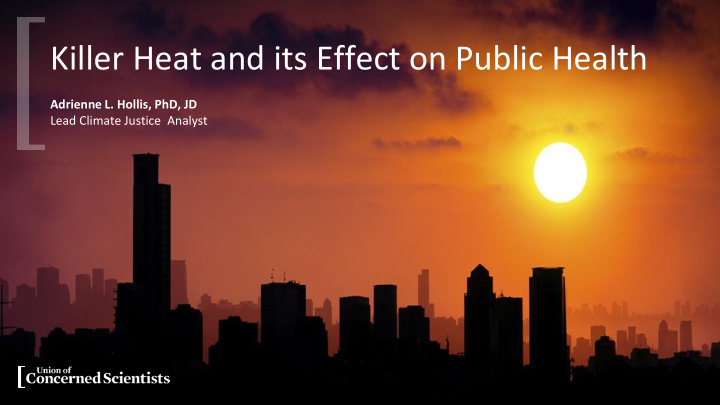



Killer Heat and its Effect on Public Health Adrienne L. Hollis, PhD, JD Lead Climate Justice Analyst
Berkeley Earth. (n/a)
(Data: Climate Prediction Center/Southeast Regional Climate Center)
It’s Us https://nca2018.globalchange.gov/chapter/2/
We’re Really, Really Sure!
It’s Bad 2.00 Global temperature change relative to 1.75 1.50 1850-1900 ( ° C) 1.25 1.00 Human-induced warming 0.75 0.50 0.25 0.00 1960 1980 2000 2020 2040 2060 2080 2100 IPCC 2018 SR15 Fig FAQ 1.2
1 ℃ World
Photo: Vermont.gove Photo: Patrick Lafreniere
Photo: U.S. Coast Guard
Current warming rate 2.00 It’s Bad Global temperature change relative to 1.75 1.50 1850-1900 ( ° C) 1.25 1.00 Human-induced warming 0.75 0.50 0.25 0.00 1960 1980 2000 2020 2040 2060 2080 2100 IPCC 2018 SR15 Fig FAQ 1.2
AP/Ross D. Franklin
About the Killer Heat Analysis • High-resolution climate models • Use temperature and humidity to calculate heat index • Three future emissions scenarios • Data for every community in the lower 48 https://iopscience.iop.org/article/10.1088/2515-7620/ab27cf
About the Heat Index
About the Scenarios
Midcentury (2036-2065): Steep increase in extreme heat
Cities with frequent, dangerous heat
Late century (2070-2099): Unprecedented heat
http://www.cdc.gov/climateandhealth/images/climate_change_health_impacts600w.j pg
A woman works as an advertising sign holder in Las Vegas during a heat wave in July 2014. While extreme heat already affects the lives of many US residents — killing hundreds each year and sending many more to the hospital with heat-related illnesses — continued global warming will cause a steep increase in extreme heat conditions nationwide.
“We have seen a huge spike in ER visits and admissions…in the past several weeks. Huge. We have been admitting people left and right.” --Dr. Arash Armin, chief of Emergency Medicine and Chief of Staff at Beaumont Hospital, Trenton, MI. July 19, 2019
Asthma and Climate Change • 11.4 Million People had asthma attacks in 2017 • >3 Million Children • African-American children – highest prevalence of asthma • 13.4% have asthma compared to 7.4% of white children • Emergency department and Urgent Care Centers – highest among Black children < 4 This Photo by Unknown Author is licensed under CC BY-ND
Adult Self-Reported Current Asthma Prevalence (%) by State or Territory, 2017 Current asthma prevalence among adults varies in states and Puerto Rico, ranging from 7.3% in Texas to 13.2% in New Hampshire. The median across all states and Puerto Rico was 9.4% with current asthma.
Current Asthma Prevalence by Race and Ethnicity: United States, 2001-2017 14 White Black Hispanic 12 Percent 10 8 6 4 2 0 2001 2002 2003 2004 2005 2006 2007 2008 2009 2010 2011 2012 2013 2014 2015 2016 2017 Year Blacks are more likely to have asthma than both whites and Hispanics. Percent of current asthma increased for whites, blacks, and Hispanics from 2001 to 2017.
This Photo by Unknown Author is licensed under CC BY-SA
Taking Action Now Limits Expansion of Extreme Heat
Our Challenge and Our Choices: Limiting Extreme Heat and Its Accompanying Harm • Putting the Nation on a Rapid Path to Reduced Emissions • Keeping People Safe from Extreme Heat • Investing in Heat-Smart Infrastructure • Investing in Climate-Smart Power Systems
Keep People Safe • Improved heat early-warning systems • State/local heat adaptation and emergency response plans • Cooling standards for public housing • Investments in community cooling infrastructure, trees, shading, cool roofs • Bill assistance programs for low-income households • Investments in heat- and climate-smart infrastructure • Reforming utility disconnect policies
Be Climate Smart - Increase renewable electricity from 18% in 2018 to at least 50% in 2035 - Nearly eliminate coal, 38% reduction in natural gas - Results in 46% decrease in power sector CO2 emissions in 2035 - Consumers would see $34 billion in savings on energy bills between 2020 and 2035
Resources Lots of localized info at http://www.ucsusa.org/killer-heat Interactive maps Interactive data widget + Spreadsheets with all the data + Spanish language webpage and materials https://es.ucsusa.org/nuestro-trabajo/calentamiento-global/calor-fatal-estados-unidos
Takeaways • Failing to take action to reduce emissions would lead to a staggering expansion of dangerous heat. • Aggressively reducing emissions could contain that expansion. • Climate Change is a Public Health Emergency. • The time to act is now.
There are no passengers on spaceship earth. We’re all crew. Photo: nasa.gov Quote: Marshall McLuhan
Thank You! Adrienne L. Hollis ahollis@ucsusa.org, @EJToxicdoc Learn more: www.ucsusa.org/killer-heat
Recommend
More recommend